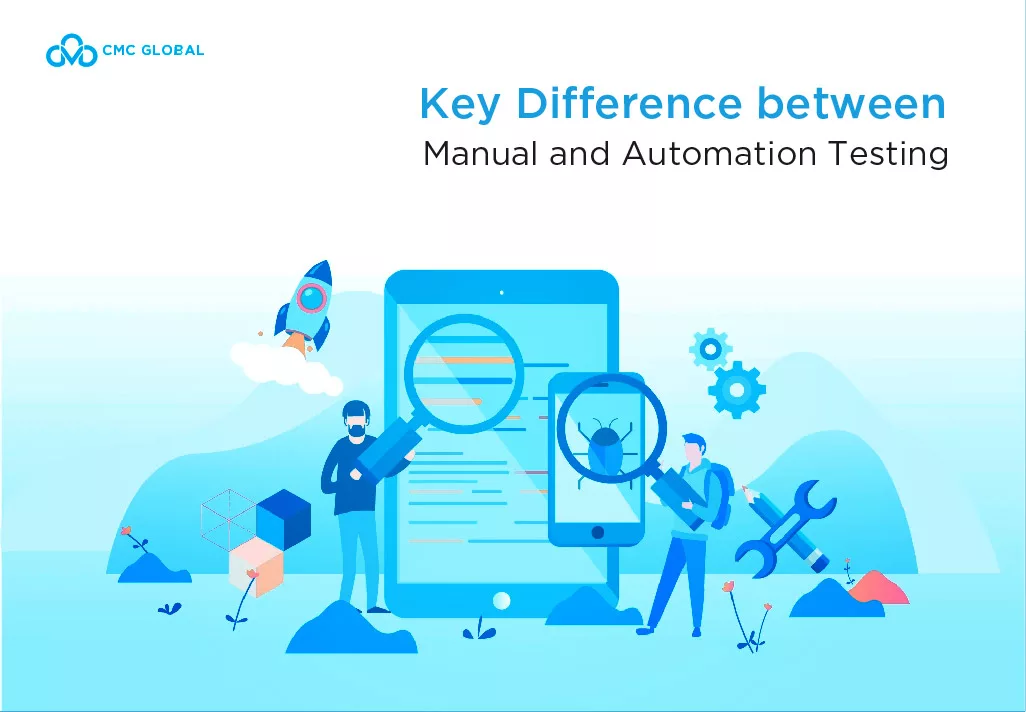Software testing is now an integral part of every development process to create a successful software project, with China, the Philippines, India, and Vietnam being preferred destinations, according to The CIO Review. However, one of the hardest dilemmas for those in need of an IT solution to face is which to choose between manual and automation testing “in other words, when to use, how to evaluate the difference between manual and automation testing to choose the right one, etc.
Today, in this article, CMC Global will guide you through the difference between these two approaches so that you have the best answer to your business and career perspective.
What is Manual Testing?
Manual Testing, as the name may suggest is a testing service executed manually only by QA Analysts. With no tools or script used, the tester checks all essential features of the software product, executes the test case, and generates test reports all by themselves. This means the knowledge of scripts is not required, resulting in a time-consuming and manual-harboring process.
Its core value is humans, this is the service that is generally conducted by experienced testers to accomplish the software testing process.
What is Automation Testing?
A key difference between Manual and Automation Testing is that in this approach, Automated Software testers write code or test scripts to automate their test execution process. This means that, apart from initial testing scripts which require some manual effort to write, the rest of the process is all automated without the intervention of a manual tester.

Automation Testing is often used for repetitive tasks
The core value here is pre-scripted tests, which automatically compare the actual results with the expected ones. Based on its comparison, the testers can determine whether the application is qualified or not. There are appropriate automation tools used to develop test scripts and validate the software with the goal to shorten the amount of testing time.
Key Difference Between Manual and Automation Testing
There is no correct answer as to define which one is better or can be used as an equal alternative since both types of testing are applied in different cases, and evaluated depending on various factors such as resources, budget, project requirements, suitability, timeline, expertise, and so on.

Below is a table to show the main differences between manual and automated testing based on critical factors as mentioned above.
| Manual Testing | Automation Testing | |
| Time | Manual testing is more time-consuming since it is based on human resources only. | With the help of pre-written scripts and technologies, automation tests are much faster than the manual approach. |
| Accuracy | This approach has higher risk due to possibly human errors | Automated testing is way more reliable and accurate because it is processed by scripts and tools. However, there are still uncertain factors because the script can only act as set to and can miss some obvious errors that manual testers can easily detect. |
| Exploratory Testing | Possible | Random testing is not allowed |
| Test reports | This approach allows human observation and evaluation of user friendliness. Testers have to use specialized programs or sites to support tests and record bugs. | The user-friendliness and experience evaluation can be missed since human interference is lacking. |
| Investment | The initial investment is lower and yet, ROI in the long term will be also lower since you have to invest more in human resources. | You have higher initial investment for hiring automation engineers and tools, but better ROI in the long perspective. |
| Knowledge | No programming skills needed | To create scripts and use tools, testers must have good programming languages knowledge |
| Frameworks | Frameworks are not used instead guidelines, checklists, and processes are used during the tests. | Framework: Selenide, Serenity, Data Driven, Hybrid, BDD, etc. |
| Cost-effective | No for high volume regression. | No for low volume regression |
| Performance Testing | Not feasible manually | There are compulsory Performance Tests such as Load Testing, Stress Testing, Spike Testing, etc. |
| Documentation | Provide no training value | This approach has huge training value especially for automated unit test cases since a new developer can understand the code base quickly just by looking into unit test cases. |
| When to Use | Usability Testing:Â The testing to measure how user-friendly and easy to use the particular software is. | Performance Testing: The testing requires the simulation of a huge number of concurrent users |
| Exploratory Testing: The testing requires testers’ experience and intuition. In this scenario, no specific approach is standardized. It is a totally unplanned testing method to understand the tester’s insight |
Load Testing: The testing to evaluate a web/ app load efficiency, playing as a part of the performance testing. | |
| Functional Testing: The automated testing allows frequent code changes in high speed, which is more accurate. | ||
| Repeated Execution: QA automation should be applied to the repeated execution of the task. |
As seen in the above table, the difference between manual and automation testing can be variable with different pros and cons. If you are still confused about these two methods, CMC Global has concluded these key differences:
- Manual Testing is manually done by a human (QA analyst), whilst Automation Testing is executed using script, code, and automation tools by a tester.
- Manual Testing can be more flawed and time-consuming due to the possibility of human errors whereas Automation testing is more reliable (but there are shrill chances of errors)
- Manual Testing doesn’t require programming knowledge whereas Automation Testing is not possible without it.
- Random testing can only be done with Manual Testing, not Automation Testing.
Consider Manual Testing in the below scenarios
First, in case your testing engineer wants to have total control over executing every action. This approach means more visual feedback to debug or find issues more easily.
Second, if you are planning for small changes or codebases, demanding quick function verification. This will be easier if you do it manually instead of configuring and spinning up a whole testing suite.
Finally, if you want to involve more human observation to find any glitches or visual bugs that automated tools can hardly detect.
Consider Automation Testing in the below scenarios
For the long term, it’s logical for a company to invest in test automation tools to set up its very own testing suite. This investment allowa them to save more money when doing these tasks:
- Do parallel testing
- Handle repetitive and time-consuming tasks
- Do non-functional testing such as load, performance, stress testing
- Avoid human errors at their max
Test Everything With CMC Global
Software Testing is an integrated part of every step of your software development process and is required to meet several specific standards, such as the ISO/IEC/IEEE 29119-1:2013 about Software and systems engineering ” Software testing. It requires not only knowledge, but also experience, intention, strategy, and time. And CMC Global is the trusted partner that can give you all.
CMC Global empowers our clients to do continuous testing and utilize test automation. Our clients can have access to everything they need with our continuous testing platform, guaranteeing the best user experiences. This includes:
- Cloud testing
- API Testing
- Automation Testing
- Web/Application/Mobile Testing
- Manual Testing
See for yourself how CMC Global can step up your testing game. Contact us now.




